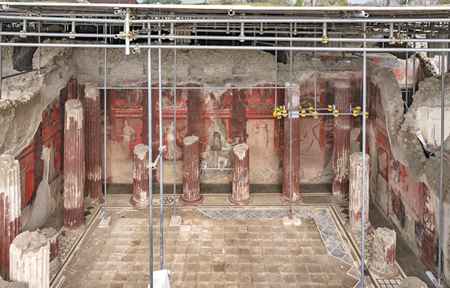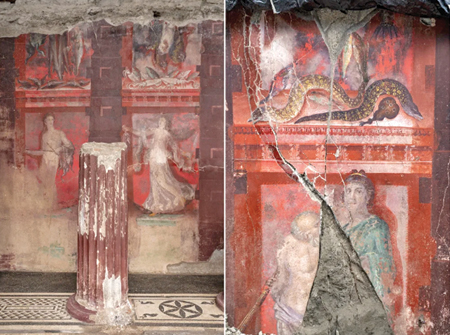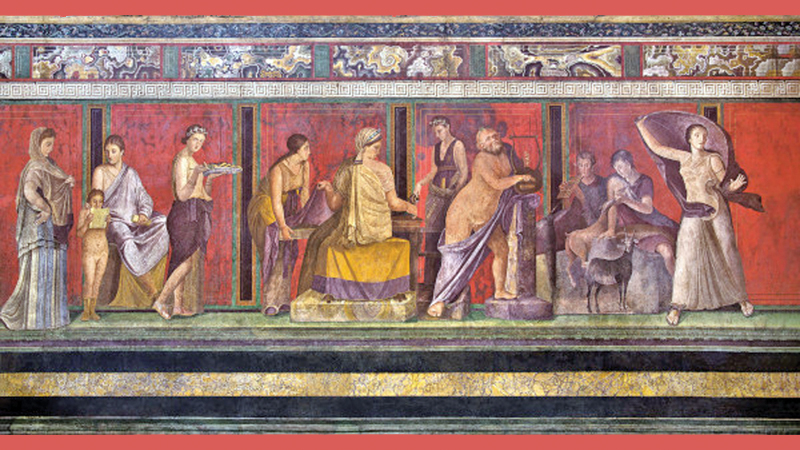 Pompeii, one of the most visited tourist sites in recent times has been making headlines across the world for its remarkable new discoveries.
Pompeii, one of the most visited tourist sites in recent times has been making headlines across the world for its remarkable new discoveries.
The latest finds are a series of wall paintings featuring ecstatic Bacchic revelries which have long held a firm root in Roman culture and these finds shed light on the mysteries that were initiated with much secrecy sometimes on the pain of death.
Just a few months ago, discoveries of a sumptuous private bathhouse and a bakery, perhaps the most extensive ever found in the location stirred renewed interest in Pompeii. This bathhouse which included hot, warm, and cold rooms, with captivating artwork, and an extensive plunge pool revealed the luxury with which some inhabitants lived. The wild side of Pompeii has been evident in the many brothels and the explicit frescoes depicting the sordid business associated with slave prostitutes. These latest finds add another dimension to the Dionysian mysteries which were shrouded in obscurity and gained a large following throughout the history of Rome.
Discovering megalography
An exceptionally rare frieze called the “megalography,” or painting of life-sized depictions of a Bacchanalian ritual spanning over three walls has been discovered in a banquet hall of a villa in the city of Pompeii. Some of the figures depicted include priests, priestesses, satyrs playing flutes, hunters with sea creatures and snakes appearing among the processional rites. The frieze dates back to the 1st century BCE, indicating that it was almost 100 years old when Mount Vesuvius erupted in 79 CE, engulfing Pompeii in pumice and pyroclastic flow killing over 2,000 of its residents.

Frieze at the House of Thiasus
The latest find, found in Region IX in the most central part of the city, illustrates a Dionysiac procession, with the Greek god of wine; Dionysius painted against red walls and columns. While priests and priestesses, known as bacchantes or maenads, are depicted as dancers, with flautists, hunters and huntresses with butchered animals draping over their shoulders. In one of the frescoes, one can see a hunter dangling a sword from which animal entrails are exposed. Another depiction of the frescoes shows a worshipper performing an acrobatic offering of wine, with libations freely gushing after him from a drinking horn.
In the middle of the frieze, there is Dionysus’ companion Silenus, and a woman on the verge of being initiated into the secrets of Dionysus. The rites consisted of ancient rituals utilising intoxicants to remove inhibitions after which initiates became part of the “mystery cults.” The rites could not be disclosed to anyone outside of the cult and, therefore, became a source of tremendous fascination to the broader masses.
All the depictions in the frieze are displayed on pedestals, while a second row of illustrations above the human figures depicts dead and live animals, sea creatures and seafood in baskets.
According to the director of the Archaeological Park of Pompeii, Gabriel Zuchtriegel, the frescoes were meant to amuse and entertain guests who had arrived at the banquet.
“Rather like when we find a copy of Michelangelo’s creation of Adam on the wall of an Italian restaurant in New York to create a little bit of atmosphere,” he said, in a press statement published on Wednesday.
“For the ancients, the bacchante or maenad expressed the wild, untamable side of women: the woman who abandons her children, the house and the city, who breaks free from male order to dance freely, go hunting and eat raw meat in the mountains and the woods,” “In other words, the direct opposite of the ‘nice’ woman who emulates Venus, the goddess of love and marriage, the woman who looks at herself in the mirror and ‘dolls herself up.’
Dubbed the House of Thiasus, which is the Greek word for the march of supporters of Dionysus, the archaeological park declared that although the park will be open to the public, only 15 persons will be accepted at a time. The megalography reveals the practices of the mysteries of Dionysus and is a unique historical record, along with the frescoes of the Villa of the Mysteries which is an exceptional testimony to an element in the life of the ancient Romans that remains relatively unknown.
Villa of Mysteries
The other depiction of Dionysian mysteries could be found in The Villa of Mysteries, discovered in 1909. It is so called because of the paintings in room 5, which date back to 70-60 BCE, a common theory is that the frescoes show a bride being initiated into the Bacchic Mysteries in preparation for marriage. In this hypothesis, the elaborate costume worn by the central figure is thought to be the wedding costume.
According to another theory, the frescoe depicts Dionysus and his bride Ariadne flanked by bacchantes, fauns and winged creatures. Specific rites were required to become a member, and most of them were secretly guarded. A key element that allows one to identify these scenes as Bacchic is the depiction of maenads, the deity’s female followers. The followers of Dionysus are often shown dancing with swirling drapery and the carcasses of wild animals draped on them in painted Greek pottery from the sixth century BCE. There are different interpretations regarding the frescoes, but they are commonly thought to portray a religious rite and the release of inhibited emotions.
Bacchanalia in Rome

Some of the figures represent priests and priestesses, as well as musicians and hunters
In 186 BCE, the Roman Senate prohibited the Bacchic rituals, known as Bacchanalia, on moral grounds implying that it was dangerously hampering the virtuosity and modesty of Roman matrons, except in particular circumstances. Nevertheless, they persisted, particularly in the South of Italy.
The Bacchanalia was an ancient Roman festival held in honour of Bacchus (also known as Dionysus, the Greek god of wine, merriment, and euphoria). Its origins can be traced back to Greece, but later as with most Greek cultural elements, gradually infiltrated Rome in a significant way. Bacchic rites became a substantial part of Roman religious life, although from time to time, they drew plenty of controversy due to their scandalous nature.
The Bacchanalia began in ancient Greece and were held in honour of Dionysus, the god of wine, drama, fertility, and ecstasy. Bacchae, the drama by Euripides is one of the best sources we have and recounts the wild escapades of the initiated and the maenads. In the play, Dionysus arrives in Thebes seeking vengeance for slander and ends with the women of Thebes being driven to a state of complete madness.
In Rome, these festivals were introduced roughly around 200 BCE when the Romans were impacted by Greek culture, particularly after the subjugation of the Greek world. Originally, the Bacchanalia were celebrated in isolated woodlands and country sides, with merriment, inebriation, and ecstatic dancing, often led by women who were the key priestesses and connected to fertility rites. The merrymakings were not exactly public affairs; but rather held as small, intimate gatherings or as covert meetings.
The late 2nd century BCE spread the Bacchanalia throughout Italy and started to earn popularity, particularly in Rome itself. Its attraction grew among the plebeians and the elite. People were drawn to the Bacchanalia due to its guarantee of freedom, emotional liberation, and the break it offered from social norms, especially for women. These celebrations included feasting, drinking, rhythmic music, and ecstatic dancing, usually held in isolated locations, like caves or hidden groves.
As the Bacchanalia started to gain a following, the number of participants swelled, and the rituals began to get more extreme and, at times, troubling. At this point, the Roman authorities started to become concerned about the possibility of disorder and political subversion associated with the rites of Bacchanalia.
Bacchanalian Conspiracy
The Bacchanalia became notorious after the “Bacchanalian Conspiracy” of 186 BCE, which led to a significant crackdown of the rites. In that year, the Roman Senate, alarmed by reports of the Bacchanalia growing out of control, started to investigate the increasingly inflammatory nature of the cult.
Roman consul Aemilius Paullus discovered a plot that implicated members of the Bacchic cult devising political and social disruption. According to the uncovering, the cult held furtive meetings and engaged in debauchery and political conspiracies and organised illicit activities. It was thought that Bacchanalian groups had morphed into breeding grounds for insurrection.
As a consequence, the Roman Senate took severe action to restrain the Bacchanalia. In 186 BCE, they passed the decree Senatus Consultum de Bacchanalibus, severely limiting the Bacchic rites. This law prohibited Bacchanalian festivals, except those that were approved by the State, and restricted the participation of women, and decreed that the rituals could only take place under strict control exerted by the State.
Following the crack down, the Bacchanalia were essentially suppressed, and their public festivities declined significantly in Rome. Although Bacchus stayed a significant deity in Roman religion, the cult’s more excessive practices and underground congregations were largely suppressed. Some of the conventional Roman festivals honouring Bacchus persisted, which were formalised and controlled to sidestep the chaos linked to the Bacchanalia. However, the legacy of the Bacchanalia lived on in multifarious forms in Roman culture. The murals uncovered in Pompeii speak volumes about how the rites continued to persist among the Romans, especially among the elite.









